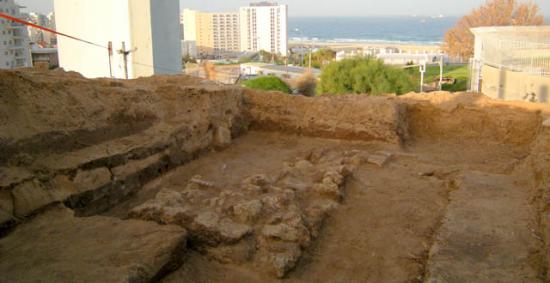First Temple Period Archaeological Discovery on the Hill of Jonah
Source - http://www.sci-news.com/archaeology/article00170.html
A team of archaeologists from the Israel Antiquities Authority has unearthed the foundation of a large fortress on the Hill of Jonah in Ashdod.

Remains of massive walls on the Hill of Jonah (Sa'ar Ganor / the Israel Antiquities Authority)
In various traditions, the Hill of Jonah (Giv’at Yonah) is associated with the burial place of the prophet Jonah.
According to the Israel Antiquities Authority, the team discovered remains of massive walls more than 1 m wide dating back to the late eighth century and early seventh century BCE.
Dr. Dmitri Egorov of the Israel Antiquities Authority suggests that these walls constituted the base of a large building from the First Temple period, the time when Jonah the prophet was active. He lived in the eighth century BCE and was famous for having been swallowed by a fish after he refused to “go to Nineveh…and proclaim against it” (Jonah1:2).
The discovery of this fortress confirms the existence of life on the Hill of Jonah during the First Temple period, in the times of this prophet, and joins other finds from an excavation that took place very close to this site in the 1960s. In an excavation directed by Magen Broshi of the Department of Antiquities, which was carried out before the construction of the Ashdod lighthouse, similar wall remains were found that date to the First Temple period and Persian period.
In addition, the archaeologists discovered an Aramaic ostracon bearing inscription “בעלצד תקלן דשנא” (a contemporary translation: Ba’altzad/Ba’altzar – a first name, Taklan – shekels, and Dashna – a present), apparently meaning that an individual named Ba’altzad contributed a sum of money that was given as a present for a holy place.
“Giv’at Yonah, which rises c. 50 m above sea level, is the highest hill in Ashdod, whence one can look out to sea, to Tel Mor – located in the Nahal Lachish estuary which was probably an ancient anchorage, and to Tel Ashdod,” said Sa’ar Ganor, the Ashkelon District Archaeologist of the Israel Antiquities Authority. “Due to its strategic location, it is not surprising to find there remains of a fortress that overlooked the region in the First Temple period.”
“There are two possibilities regarding who inhabited the fortress at that time: one possibility is that it was controlled by the Assyrians who were the regional rulers in the Iron Age. Another possibility is that Josiah, king of Judah, occupied the fort at the time, who we know conquered territory from the Assyrians and controlled Ashdod-Yam in the seventh century BCE,” he concluded.